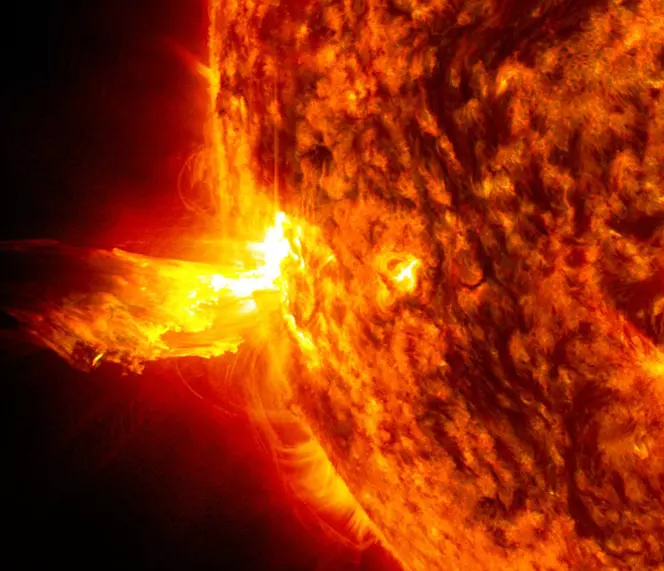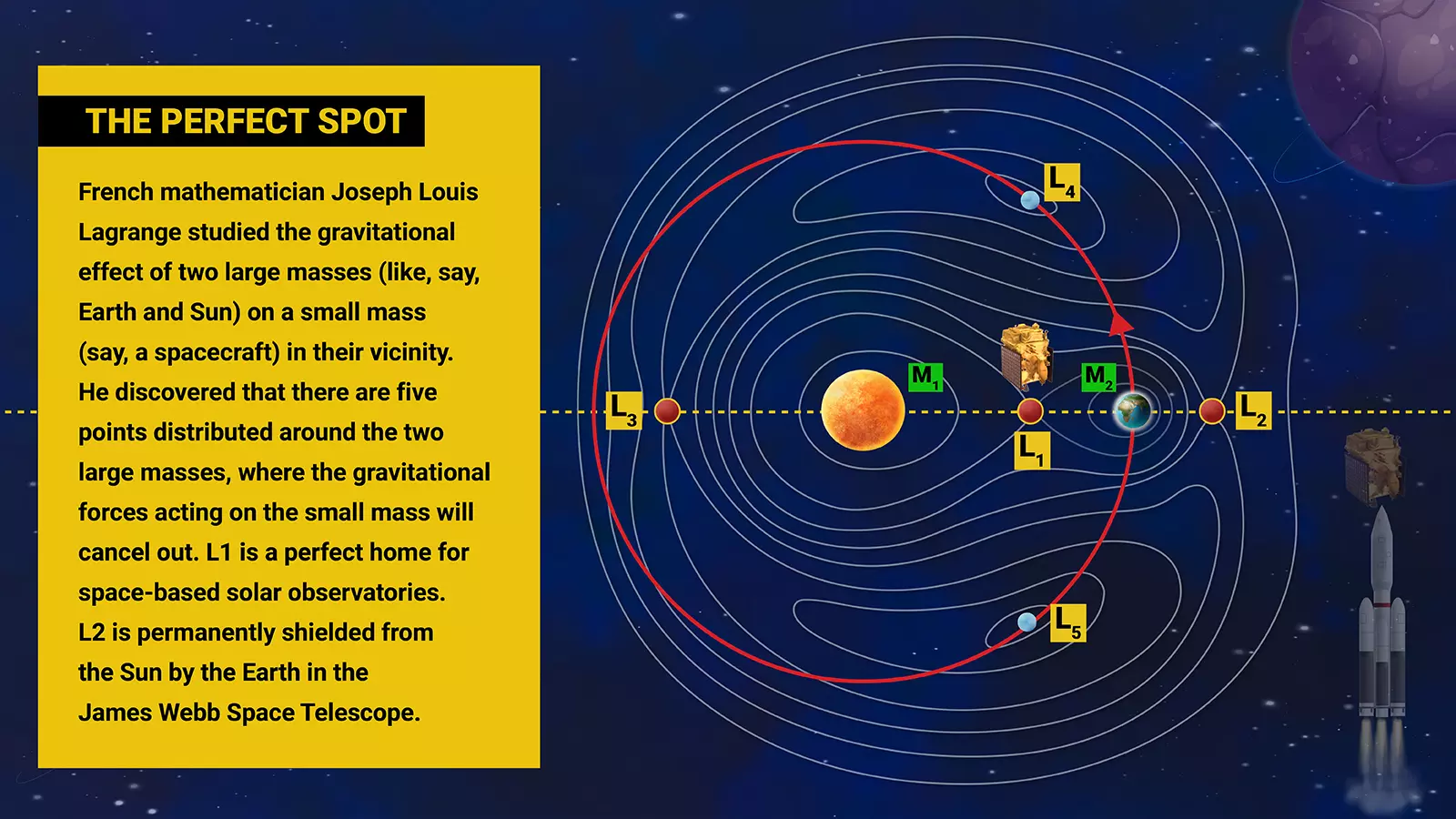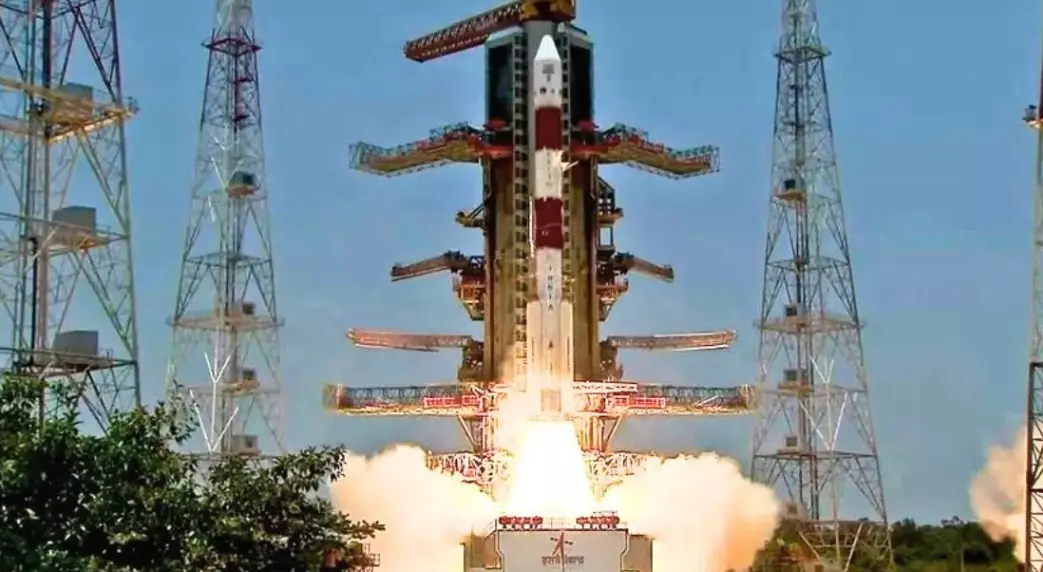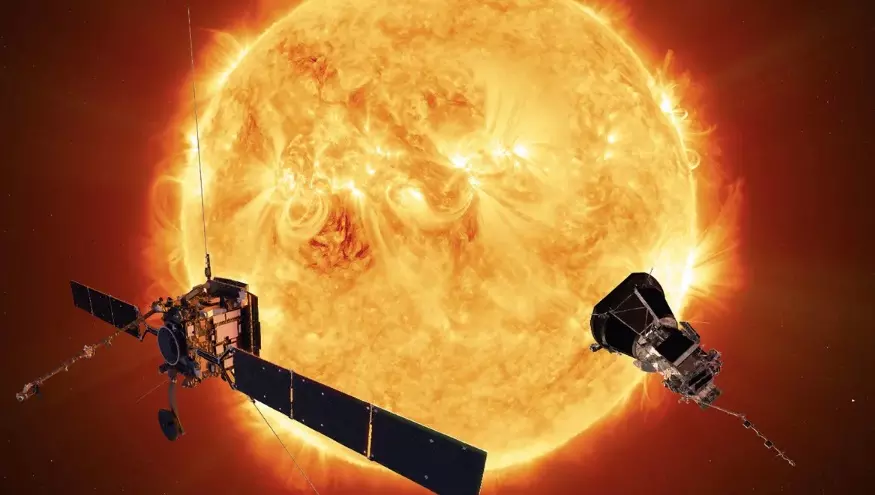
- Home
- India
- World
- Premium
- THE FEDERAL SPECIAL
- Analysis
- States
- Perspective
- Videos
- Sports
- Education
- Entertainment
- Elections
- Features
- Health
- Business
- Series
- In memoriam: Sheikh Mujibur Rahman
- Bishnoi's Men
- NEET TANGLE
- Economy Series
- Earth Day
- Kashmir’s Frozen Turbulence
- India@75
- The legend of Ramjanmabhoomi
- Liberalisation@30
- How to tame a dragon
- Celebrating biodiversity
- Farm Matters
- 50 days of solitude
- Bringing Migrants Home
- Budget 2020
- Jharkhand Votes
- The Federal Investigates
- The Federal Impact
- Vanishing Sand
- Gandhi @ 150
- Andhra Today
- Field report
- Operation Gulmarg
- Pandemic @1 Mn in India
- The Federal Year-End
- The Zero Year
- Science
- Brand studio
- Newsletter
- Elections 2024
- Events
How Aditya L1 will make peace with solar flares and massive Sun storms

A massive solar flare erupted on January 30, 2022, at 5.02 am (IST). A few minutes later, at 5.23, the space-based solar observatories witnessed the outburst of massive coronal mass ejections (CMEs).Solar flares are massive explosions on the Sun that unleash energy, light and high-speed particles into space. These flares are often associated with solar eruptions, known as coronal mass...
A massive solar flare erupted on January 30, 2022, at 5.02 am (IST). A few minutes later, at 5.23, the space-based solar observatories witnessed the outburst of massive coronal mass ejections (CMEs).
Solar flares are massive explosions on the Sun that unleash energy, light and high-speed particles into space. These flares are often associated with solar eruptions, known as coronal mass ejections (CMEs). The main difference between flares and coronal mass ejections (CMEs) is that flares mainly emit X-rays, visible light and ultraviolet radiation. Still, CMEs actually expel mass from the Sun’s atmosphere into space. During CME eruption, a billion tonnes of plasma mixed with a solar magnetic field is ejected from the solar corona, the ‘atmosphere’ of the Sun, into the outer interplanetary space. Travelling at very high speeds, this massive and dense particle cloud collides with Earth’s magnetosphere, triggering what is known as a geomagnetic storm.
The one that erupted that day was the M1.1 class solar flare. In the scale, A (background levels), followed by B, C, M, and X, each representing a fold increase in energy (means M class is 10 times C), M1.1 was considerably strong.
Space-based solar telescopes went overdrive. Solar physicists found that the ejected plasma travels at a breakneck speed of 440-620 kilometres per second. Assuming the constant rate of the propaga-tion, they computed that the blast of electrons, protons and other charged particles would reach the Earth some 151 million kilometres away. They forewarned that a massive geomagnetic storm would likely strike the Earth between February 1 and 3, 2022. As predicted, a strong geomagnetic storm was observed on February 2, 3.07 am IST.

Solar flares are massive explosions on the Sun that unleash energy, light and high-speed particles into space.
Knocks spacecraft
As these energetic particles strike the upper atmosphere, the energy is transferred, and the layer expands. Notably, the phenomenon is more pronounced in the thermosphere, the layer of Earth's atmosphere that extends from about 80 kilometres to 1,000 km above the Earth’s surface. As the thermosphere expands, the density of the layer significantly alters.
Hundreds of Low Earth Orbit (LEO) satellites go around the Earth at a height of about 400 to 1,000 km from the surface of the Earth. When a solar storm strikes, the increasing density of the expand-ing thermosphere drags the satellites, destabilising and displacing them from their orbits. Once the storm quietens, the ground control fires the onboard thrusters to reposition the satellites. Each time a geomagnetic storm blows, the spacecraft consumes some of the fuel stored in them. Once the fuel tank empties, the craft enters the Earth’s atmosphere and burns or orbit as space junk, ending its life. Geomagnetic storms are satellite killers.
Despite the warning, SpaceX launched 49 Starlink satellites at 23.43 IST on February 3, 2022. The plan was to leave the satellites at an altitude of 210 km and, using the onboard thrusters, raise the height to 340 km. Due to the geomagnetic storm, the atmospheric drag had increased by 50%. De-spite operating at full power, the feeble thrusters of the satellites could not bear the excess drag and slowly started falling towards the Earth. Finally, one by one, 38 of the 49 satellites re-entered the atmosphere and burned up in the next few days.

The Starlink story is dramatic but not the lone example of inclement space weather destroying spacecraft at low earth orbits. “Predicting space weather has become a global concern with thou-sands of satellites orbiting Earth,” says Dipankar Banerjee, a solar physicist and the Director of Aryabhatta Research Institute of Observational Sciences (ARIES) Nainital. “ISRO alone has 50,000 crore worth of space assets, and knowing in advance the brewing geomagnetic storm is im-perative,” he adds.
Space weather is studying the conditions in the region of space close to the Earth, especially the presence of electromagnetic radiation and charged particles emitted by the Sun and how it can im-pact the Earth’s magnetosphere, ionosphere, thermosphere, and exosphere.
Aditya L1, India’s first solar space observatory, was launched on September 2, 2023. Since then, it has been on its way towards the L1, the first Lagrangian Point, about 1.5 million km, nearly four times the distance of the Moon. The craft is expected to reach L1 by January 2024.
The High Energy L1 Orbiting X-ray Spectrometer (HEL1OS), an instrument aboard Aditya L1, was commissioned on October 27, 2023, while the craft was en route. During the fine-tuning and calibration operations, on October 29, 2023, it recorded the ‘impulsive phase of solar flares’.

Aditya L1, India’s first solar space observatory, will keep a tab on the space weather.
Once lodged in its parking slot, halo orbit around the L1 point, using the Aditya Solar Wind Particle Experiment (ASPEX), Plasma Analyser Package for Aditya (PAPA) and the Magnetometer, Aditya L1 can monitor the change in the speed, density and direction of the solar wind and help us predict the space weather. “Modern society relies heavily on communication systems, navigation, and power grids. Space weather events like solar storms can disrupt these systems by inducing ge-omagnetic storms, radio signal interference, and damaging satellites. Predicting space weather helps mitigate these disruptions,” says Joshi, Jayant, Assistant Professor studying Solar Magnetism at the Bengaluru-based Indian Institute of Astrophysics.
The Sun is still a bundle of puzzles.
Broadly, we know how long ago the Sun was formed. We know its mass, size and total irradiance reasonably well. First-generation stars had only Hydrogen and Helium from the Big Bang. Howev-er, the Sun has many higher elements. From this, we know that the Sun must be a second or third-generation star. Our theoretical model shows how it has evolved into a mid-aged star. Further, it will develop into a red giant stage and die as a white dwarf star in the next 500 crore years.
Yet, there are quite a lot of puzzling aspects which we still need to figure out. The point where the gravity and magnetic attraction are so low that the upwelling plasma from the solar surface could escape is called Alfvén critical surface; this marks the end of the solar atmosphere and the begin-ning of the interplanetary space.
How far does the Alfven line extend? Until recently, this remained a subject of speculation, with estimates ranging between 140 lakh km to 70 lakh km from the surface of the Sun. On April 28, 2021, the Solar Parker probe encountered the Alfvén line. From that data, we now know the solar corona extends to about 130 lakh km from the surface of the Sun. We now know how big the solar atmosphere is.
When the gentle wind turns ferocious
Sun is a hot ball of gas and plasma. When you heat a solid, it melts and becomes liquid. When you boil the liquid, it turns into gas. As more and more energy is added to gas, electrons are stripped off, leaving the positively charged nucleus naked. The soup of these electrons, positively charged protons, and nuclei is called plasma. On Earth, we rarely encounter the plasma state, for example, in the flash of lightning. Sun and Sun’s atmosphere, called corona, is composed mainly of plasma mixed with various gases.
The corona is bound to the Sun through the magnetic field and gravity. As you leave the Sun, the gravitational attraction and magnetic field weaken, permitting most energetic plasma particles to escape into the interplanetary space as solar wind.
Unlike Earth, the Sun is not rigid and has differential rotation around its axis. The gasses and plasma at the equator take only 25 days to make one rotation, while those at the poles take 36 days. The magnetic lines of forces from the Sun’s intense magnetic field are initially smooth closed loops flowing from the north pole to the south pole outside the Sun. The faster-moving equatorial parts drag along these lines, and the smooth lines get twisted and tangled like a bowl of noodles over time.
The tangled regions produce a strong localised magnetic field, seen in telescopes as ‘sun spots’, a black spot on the solar disc. Many things can occur when the messy lines snap like a twisted rubber band.
The broken magnetic field lines can stream from the Sun into interplanetary space, resulting in a ‘coronal hole’. Like a bullet train speeding along the track, the Solar wind plasma can flow quickly out following the magnetic field lines. The streaming charged particles now speed up and charge at 700–800 km; a solar storm brews.
The twisted magnetic field near the sunspots can snap and realign into a less tense configuration called magnetic reconnection. A solar flare erupts, often from a region as big as Earth, releasing the stored magnetic energy through electromagnetic solid waves, primarily as X-rays, visible light and ultraviolet rays, lasting minutes to hours. Often, the strongest flares are followed by Coronal Mass Ejections (CMEs), large expulsions of plasma and a magnetic field from the Sun’s corona. Like boiling milk, the twisted lines swell up, taking billion tonnes of magnetised plasma and hurl-ing them into space.
“Small and large solar flares arise, and the current space-based instruments can only detect either. Adtiya L1 with its Solar Low Energy X-ray Spectrometer (SoLEXS) and the High Energy L1 Or-biting X-ray Spectrometer(HEL1OS) can detect both,” says Dipankar.
What makes the Sun erupt
If the Earth happens to come in the way of these speeding clouds of magnetised energetic particles, Earth’s magnetic field, magnetosphere, is bombarded, triggering a geomagnetic storm.
What activates and drives explosive outbursts like solar flares and coronal mass ejection remains unanswered.

Illustration of Parker Solar Probe approaching the Sun. Photo: NASA
In the dazzling brightness of solar irradiance, the corona is invisible. Astronomers use a special telescopic attachment, coronagraph, which can artificially eclipse the direct light from the star or Sun and enable us to see nearby objects such as corona. Hitherto, the space-based telescopes have been able to peer at the corona beyond 7,50,000 km from the surface of the Sun. However, the trigger mechanism, theory tells us, is located in a region below 3,50,000 km from the surface of the Sun.
“The Visible Emission Line Coronagraph (VELC) on board Aditya-L1 is designed to observe the innermost corona, which is not covered by any existing coronograph from space; therefore, it fills the critical gap vital for our understanding of the corona,” says Jayant Joshi, adding, “Understand-ing coronal mass ejection’s kinematic and initiation process is very important for space weather prediction. Aditya-L1 promises to help on this front.”
The enigmatic superhot corona
As would one expect, the core of the Sun, where the cataclysmic thermonuclear fusion crushes four hydrogen and makes them into one nucleus of Helium and releases energy in the process, is super hot, some 15,000,000 degrees. As we move away from the core, the temperature drops, the radia-tive layer enveloping the core is only 7,00,000 degrees, and the surface, the photosphere, is just 5,600 degrees. There are no surprises so far.
The lower region of the Sun's atmosphere, called the chromosphere, extending to some 2000 km from the surface, is puzzlingly hotter than the surface. The temperature is 4,000 degrees at the lower region, but it sizzles 14,000 degrees at the top. The mystery deepens as we climb higher and reach the next layer of the atmosphere, the solar corona. It is blistering one million degrees.
Called coronal heating problem, the enigma of how the atmosphere of the Sun is hotter than the surface is still unresolved. While some claim that the solar magnetic field heats up the corona much like the induction stove, others propose waves travelling away from the interior of the Sun feed the required energy and heat up the corona.
“By throwing light on the processes through which the energy is channelised and transferred from the photosphere to the chromosphere, Aditya L1 will be able to provide a better insight into the coronal heating mystery,” says Ravindra Belur, professor of Solar Physics at Bengaluru-based In-dian Institute of Astrophysics.
The Sun and Earth’s climate
Another intriguing aspect of the Sun is its sunspots. They appear like a black dot against the white disk of the projection of the Sun on a screen. The magnetic field is much stronger in these spots, and the temperature is less relative to its surroundings. Like the heaves of the waves, the number of sunspots wax and wane in 11 years. At the beginning of the 11-year solar cycle, the first sunspots emerge through the solar surface near the equatorial regions of the Sun. Soon, like the measles rash, the sunspots erupt and move to the mid-latitudes. When the numbers run into hundreds, solar maximum is attained. Although the sunspot cycle is about 11 years long, predicting the timing and intensity of solar maximum is still hard.
To add a further twist, there were very few sunspots between 1645 CE and 1715 CE, as if the Sun went into sleep mode. This period coincided with the 'Little Ice Age', a significant climatic change when the Earth's average temperature plummeted. Studies have shown that the number of sunspots seen during the maximum of the last few cycles shows a downward trend. Is there a connection between the sunspot cycles and the climate change on Earth? In the era of global warming, the an-swer to this question is crucial.
“UV radiation from the Sun undergoes cyclical changes, primarily linked to the 11-year solar ac-tivity cycle, characterised by a shift in the number of sunspots and solar flares. These fluctuations hold significant implications for a range of Earth processes, such as atmospheric chemistry,” says Jayanth Joshi. The Solar Ultra-violet Imaging Telescope (SUIT) payload onboard Aditya L1 will be able to image the Solar Photosphere and Chromosphere in near Ultra-violet (UV) and constantly measure the solar irradiance variations in near UV.
Expect the unexpected
Space missions are planned considering what we know, what the knowledge gaps are and what kind of instruments can fill the cracks and complete the observations to advance our understand-ing. The VELC can observe much closer to the solar disc to tease out near surface triggers of CMS and flares; the SUIT instrument can take rapid images of the solar disc at various heights using several filters and create a 3D tomography of unfolding eruptions.
“We have certain expectations from the Aditya L1. We hope that the four remote sensing and the three in-situ instruments will enable us to unravel various mysteries of the Sun,” says Dipankar. “But the beauty of research with new instrumentation is the possibilities of unanticipated discover-ies. For example, the Parker Solar Probe was to study and provide us with data on solar wind. In the wake, it discovered an unexpected phenomenon called ‘switchback’, rapid flips in magnetic field direction. This is the most important discovery of the Parker Solar Probe, which no one imag-ined,” he adds. What is in store for Aditya L1; who knows?
